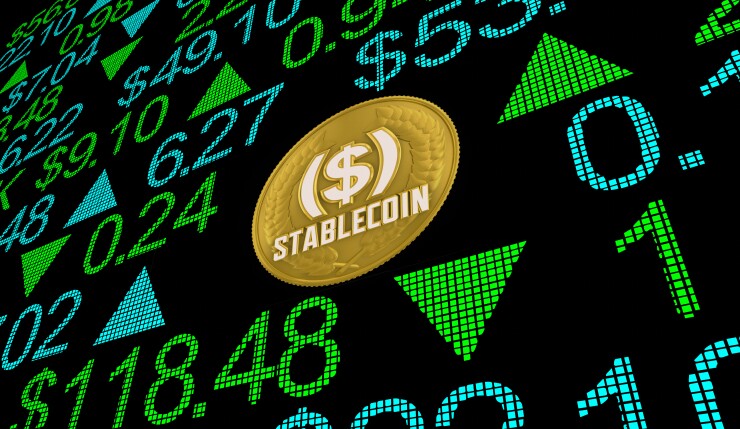
The rush to offer stablecoins has thus far included more large banks and retailers than credit unions and community banks. While the GENIUS Act requires smaller financial institutions to pay attention, there's likely just as much risk to jumping in quickly than waiting too long.
"Large banks have the resources to experiment with stablecoins and develop business cases for their use," Enrico Camerinelli, a strategic advisor at Datos Insights, told American Banker.
Betting on the
The dominance of international corporations among early movers mirrors other areas of bank technology, such as artificial intelligence and payment tech, where
Since stablecoins still lack a clear use case for U.S. banking and payments, there is an opportunity to see how the market evolves, according to Camerinelli.
"Smaller institutions and credit unions should resist the temptation to hastily launch their own stablecoins," he said. "Instead, they would be better served by monitoring the market's evolution and identifying which emerging applications align with their strategic goals."
'Democratizing' stablecoins
Fiserv's announcement that it would
FIUSD enables banks and credit unions to retain more control of customer relationships, to earn net interest income off FIUSD, and to support their retail and commercial clients with more efficient real-time global money movement services, according to Sunil Sachdev, head of embedded finance at Fiserv.
"As the service matures, the programmability of blockchain payments through stablecoins will also help these banks and credit unions add data, provide unique settlement features, and create greater transparency across all payments," Sachedv told American Banker. "Beyond payments, these institutions will also have the opportunity to create tailored financial products on-chain, like mortgages, based on individual cash flows."
Fiserv will also support deposit tokens to enable the benefits of stablecoins in a more "capital-friendly structure" for banks. That would allow a wider range of banks to compete with large banks such as
"We're looking to really democratize and enable access to all shapes and sizes, so firms can offer the broadest payment choices to their customers," Sachdev said.
Other firms are attempting to bring credit unions into the stablecoin market. Blockchain technology company
The program is open to participants in Metallicus' Metal Blockchain Banking Innovation Program, a payments tech incubator that has more than 750 credit unions among its members.
Metallicus' stablecoin program enables credit unions to simulate branded stablecoins. In an email to American Banker, Metallicus did not disclose participants, but said pilots would begin later in the summer, and "we are seeing rapidly growing interest from credit unions eager to deploy compliant, institution-issued stablecoins — especially as federal guidance advances through legislation like the GENIUS Act."
Who is biting?
Teachers Federal Credit Union Chief Experience Officer Inna Sprague told American Banker that stalecoins are "something we are actively watching and exploring."
Stanford Credit Union, which is a client of Fiserv, and Navy Federal Credit Union were noncommittal.
"As the digital currency landscape continues to evolve, we are committed to evaluating technologies that offer safety, speed and value to our members," a Navy Federal Credit Union spokesperson told American Banker.
Aaron McPherson, principal at AFM Consulting, said, "There is a lot of pressure on smaller banks and credit unions to have a strategy, but I believe it is mostly hype at this stage."
McPherson noted
"In international trade, where reserves are needed to ensure liquidity, this is not a serious drawback, but for domestic payments, it is a lot less efficient than the debit cards we already have," he said.
Another problem with stablecoins is there are already too many of them, McPherson said. "There is no way to differentiate one from the other, so they will just cause confusion."
Fiserv positioned stablecoins as part of a broader menu of payment tech options.
"Whether it's FedNow, pay by bank, Zelle or ACH, as stablecoins become more regulated, the signal we're getting is that we need to add stablecoins to the capabilities that we already have," Sachdev said.






